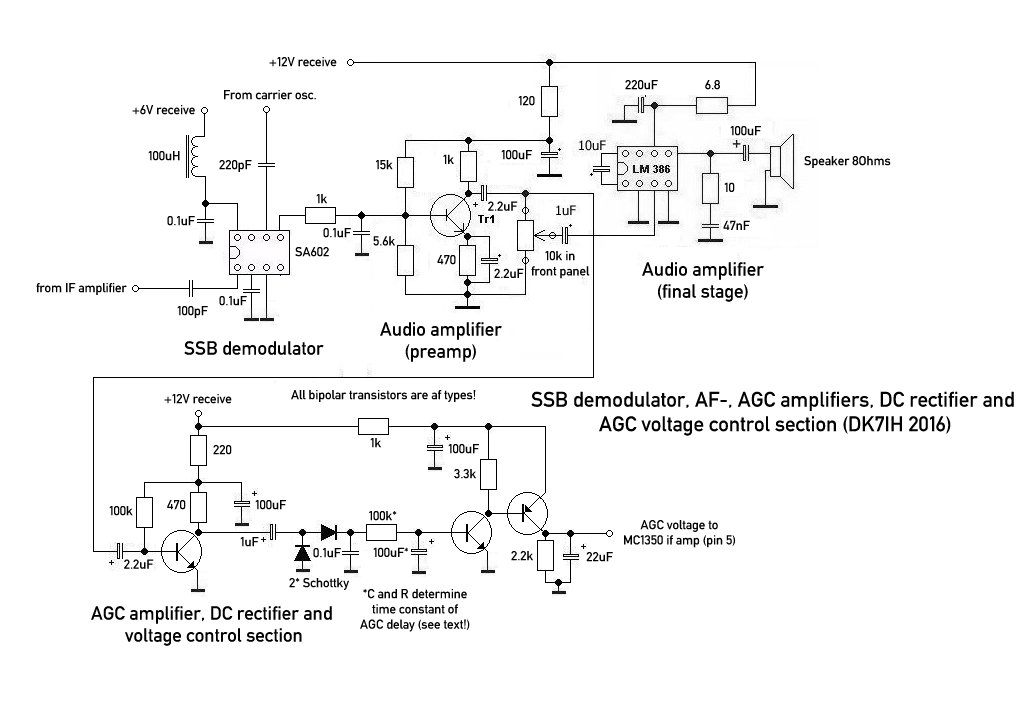The demodulator section of the transceiver’s receiver starts with the product detector, which is made of another SA602. To get more audio volume a preamplifier has been added before the LM386 follows.

The AGC section hast got 2 crucial components: One resistor (this case 100k) and an electrolytic capacitor (in this case 100uF): They determine the time ramp for the AGC regulation curve. This means they define the response and decay time for the AGC and thus should be made easily changable for example by putting them into socket strips.
Hint: In certain cases it can be useful to add a potentiometer to give you control on the audio input of the AGC preamplifier.
Thanks for watching!
73 de Peter
The attack time of AGC looks ridiculously loooong. Tau= 100kOhm * 100uF = 10s ! Am I missing something?
Maybe the fact that the capacitor is connected directly to the base and therefore discharges rapidly? And that there is a high amplfication in the AGC amplifier strip that will show the first effect on the MC1350 long before the capacitor is fully charged?
Yes, it uses very small amount of a charging curve (even if 1/100ths, its still 100ms – way too much), and then again – where is proper decay time constant chain built in?
Look at these: http://www.karinya.net/g3txq/cubii/bfo.jpg and http://www.sgcworld.com/Publications/Manuals/2020man.pdf (page 57), also some Ten-Tec models used this circuitry for the MC1350. I have tried – works very well for audio derived AGC! Attack time here is defined by R=270 Ohm and C=10uF (RC=2,7ms), decay time – by R=330k and the same capacitor (RC=3,3s).
Have You done any audio recordings from your transceiver?
Yes, it uses very small amount of a charging curve (even if 1/100ths, its still 100ms – way too much), and then again – where is proper decay time constant chain built in?
Look at these: http://www.karinya.net/g3txq/cubii/bfo.jpg
and http://www.sgcworld.com/Publications/Manuals/2020man.pdf (page 57), also some Ten-Tec models used this circuitry for the MC1350.
I have tried – works very well for audio derived AGC! Attack time here is defined by R=270 Ohm and C=10uF (RC=2,7ms), decay time – by R=330k and the same capacitor (RC=3,3s).
Have You done any audio recordings from your transceiver?
Look here:
https://www.youtube.com/watch?v=IwYl0guMHX0
The built in (rather squeezed in :)) speaker sound quite good. But AGC works terrible (too slow in attack, and may be faster than needed at release). Yes, the attack time really is in a 100ms ball park, when it should be around 1ms.
I enjoy some mystery of disappearing and then appearing again comments on the page ;))
In contrary, how the proper AGC circuit (with the same number of components) works: https://www.youtube.com/watch?v=ZwV3JG_29ws (look at around 1:55 and after around 8:00)
Hello Peter, i read to proyect, is posible optain the complet circuit?, i have 3 parts of the proyect.
Hello Orlando,
I’m sorry, but I haven’t found time to complete the description because I’m concerned with other projects currently. 73 de Peter